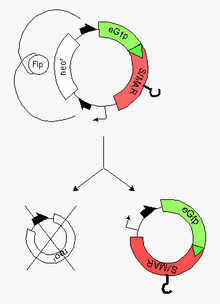
Minicircles are small (~4kb) circular replicons. They occur naturally in some eukaryotic organelle genomes. In the mitochondria-derived kinetoplast of trypanosomes, minicircles encode guide RNAs for RNA editing.[1] In Amphidinium, the chloroplast genome is made of minicircles that encode chloroplast proteins.[2][3]
- ^ "Kinetoplastids and Their Networks of Interlocked DNA". Retrieved September 2, 2019.
- ^ Barbrook, Adrian C.; Voolstra, Christian R.; Howe, Christopher J. (2014). "The Chloroplast Genome of a Symbiodinium sp. Clade C3 Isolate". Protist. 165 (1): 1–13. doi:10.1016/j.protis.2013.09.006. hdl:10754/563301. PMID 24316380.
- ^ Dorrell, Richard G.; Nisbet, R. Ellen R.; Barbrook, Adrian C.; Rowden, Stephen J.L.; Howe, Christopher J. (2019). "Integrated Genomic and Transcriptomic Analysis of the Peridinin Dinoflagellate Amphidinium carterae Plastid". Protist. 170 (4): 358–373. doi:10.1016/j.protis.2019.06.001. PMID 31415953. S2CID 198240765.